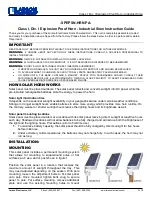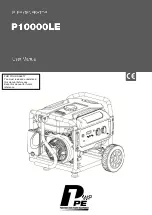
©
2010 Magnum Energy, Inc
.
22
3.0 Operation
Operating Modes
The MM Series inverter has two normal modes of operation; Invert
Mode, which powers your loads using the batteries, and Transfer Mode,
which powers your loads from the incoming AC power (i.e., shore pow-
er or a generator). This inverter also has extensive protection circuitry
and will go into the Protection Mode under certain fault conditions.
Invert Mode
In Invert Mode, the
inverter
supplies AC power to your appliances
by inverting the DC power from the battery.
The amount of time th
e
inverter can provide power is directly related to the capacity of the
battery (or battery bank).
Transfer Mode
The inverter will automatically go into Transfer Mode whenever an ex-
ternal AC source is connected and allowed to pass through to power
your AC loads. While in Transfer Mode, the AC input is continually
monitored to ensure it remains between 80 VAC (determined by the
‘Adj VAC dropout’ setting) and 140 VAC. The status LED indicator will
be on (Transfer Mode), or blink off every four seconds (battery charg-
ing) to indicate that the inverter is passing the input AC power to the
output and monitoring the AC input. Whenever AC power is discon-
nected or falls below the 80 VAC threshold, the inverter automatically
transfers back to the Invert Mode with minimum interruption to your
appliances – as long as the inverter is enabled (turned on).
Info:
You must use the ME-RC remote to adjust the VAC
dropout setting – which in turn determines the VAC dropout
threshold.
Transfer time -
When the AC power falls below the VAC dropout
threshold voltage (80 VAC, default setting), the relay transfers from
Transfer Mode to Invert Mode in about 16 milliseconds. While the MM
Series is not designed as a computer UPS system, this transfer time
is usually fast enough to hold them up. However, the VAC dropout
setting has an effect on the ability of the loads to transfer without
resetting. The lower this setting, the longer the effective transfer will
be and therefore, the higher the probability for the output loads to
reset. This occurs because the incoming AC voltage is allowed to fall
to a level that is so low, that when the transfer does occur (in addi-
tion to the relay transfer time), the voltage from the inverter’s output
has already fallen to a low enough level to reset the loads.
The disadvantage of a higher VAC dropout setting is that smaller gen-
erators (or large generators with an unstable output) may nuisance
transfer. This commonly happens when powering loads that are larger
than the generator can handle – causing the generator’s output to
constantly fall below the inverter’s VAC dropout threshold.
When switching from Invert Mode to Transfer Mode, the inverter waits
approximately 15 seconds to ensure the grid is stable (or the genera-
tor is up to speed) and then makes the transfer in approximately 8
milliseconds.
3.0 Operation
Содержание MM Series
Страница 1: ...Owner s Manual MM Series Inverters ...
Страница 43: ... 2010 Magnum Energy Inc 37 ...
















































